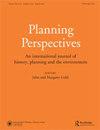State of the legacy: reviewing a decade of writings on the regeneration promises of London 2012
IF 0.9
3区 历史学
0 ARCHITECTURE
引用次数: 1
Abstract
necting architectural design, urban planning, and landscape architecture. The fourth chapter, ‘Reconstructing the City, constructing New Towns,’ describes heterogeneous experiences connected by a shared attention devoted to the memory of war destruction, comparing divergent approaches and projects like the global reconstruction plan of Hiroshima by Kenzo Tange – framed in the context of the tabula rasa caused by the nuclear apocalypse -, and the series of numerous (700) small playgrounds proposed by Aldo van Eyck in the interstices of the historic city of Amsterdam. Finally, the authors devote special attention to the role of criticism in the debates on urban design, which flourished in parallel with the evolution of urban proposals. The work reveals numerous conflicts and contradictions, as exemplified by the debates on the New Towns, which originated multiple forms of criticism and resistance in the UK, France, and Scandinavia. Chapter 8, titled ‘Finding Meaning in the Postmodern City,’ traces with rigour and acuteness the divergent and articulated positions which emerged in the 1970s and 1980s as a reaction to functionalist planning, starting from the diverse forms of radical criticism offered by the publications and projects of Vittorio Gregotti, Oswald Mathias Ungers, and Aldo Rossi, but also in the ‘anti-modern’ positions of Colin Rowe, Robert Venturi, and Denise Scott Brown. Excessive importance is probably assigned to the role of Léon Krier, whose singular trajectory took him from the condition of brilliant draftsman of Jim Stirling’s perspectives to a radical polemicist and the favourite architect of Prince Charles in his campaign against modern architecture. Concerning the international movement for the ‘Critical Reconstruction of the European City,’ more than Léon, it is possibly his brother, Rob Krier, who deserves to be remembered, along with other contemporary protagonists, including Álvaro Siza, Herman Hertzberger, John Hejduk, and Vittorio Gregotti and Oswald Mathias Ungers themselves, for the exemplary contribution in what was the most critical laboratory of those years: the Internationale Bauaustellung (International Building Exhibit IBA) in West Berlin, under the guidance of Josef Paul Kleihues.遗产状况:回顾关于2012年伦敦重建承诺的十年著作
连接建筑设计、城市规划和景观建筑。第四章“重建城市,建设新城”描述了由对战争破坏记忆的共同关注所连接的异质经验,比较了不同的方法和项目,如丹戈贤三的广岛全球重建计划——以核灾难造成的白板为背景——,以及Aldo van Eyck在历史名城阿姆斯特丹的空隙中提议的一系列(700)小游乐场。最后,作者特别关注批评在城市设计辩论中的作用,这场辩论与城市提案的演变同时蓬勃发展。这部作品揭示了许多冲突和矛盾,例如关于新城的辩论,这场辩论在英国、法国和斯堪的纳维亚引发了多种形式的批评和抵制。第8章题为“在后现代城市中寻找意义”,从Vittorio Gregotti、Oswald Mathias Ungers和Aldo Rossi的出版物和项目提供的各种形式的激进批评开始,严谨而尖锐地追溯了20世纪70年代和80年代作为对功能主义规划的反应而出现的分歧和明确的立场,但也处于科林·罗、罗伯特·文丘里和丹尼斯·斯科特·布朗的“反现代”立场。莱昂·克里尔(Léon Krier)这个角色可能被赋予了过高的重要性,他的独特轨迹使他从吉姆·斯特林(Jim Stirling)视角下出色的绘图员变成了一位激进的辩论家,也是查尔斯王子反对现代建筑运动中最受欢迎的建筑师。关于“欧洲城市关键重建”的国际运动,可能比莱昂更值得纪念的是他的兄弟罗伯·克里尔,以及其他当代主角,包括阿尔瓦罗·西扎、赫尔曼·赫茨伯格、约翰·赫杜克、维托里奥·格雷戈蒂和奥斯瓦尔德·马西亚斯·昂格尔本人,在Josef Paul Kleihues的指导下,在西柏林的Internationale Bauaustellung(国际建筑展览IBA)实验室做出了杰出贡献。
本文章由计算机程序翻译,如有差异,请以英文原文为准。
求助全文
约1分钟内获得全文
求助全文
来源期刊

Planning Perspectives
Multiple-
CiteScore
1.50
自引率
12.50%
发文量
85
期刊介绍:
Planning Perspectives is a peer-reviewed international journal of history, planning and the environment, publishing historical and prospective articles on many aspects of plan making and implementation. Subjects covered link the interest of those working in economic, social and political history, historical geography and historical sociology with those in the applied fields of public health, housing construction, architecture and town planning. The Journal has a substantial book review section, covering UK, North American and European literature.
 求助内容:
求助内容: 应助结果提醒方式:
应助结果提醒方式:


